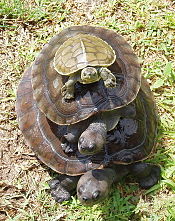
The Geoemydidae are one of the largest and most diverse families in the order Testudines (turtles), with about 70 species. The family includes the Eurasian pond and river turtles and Neotropical wood turtles. Members of this family are commonly called Leaf turtle.

The keeled box turtle is a species of turtle in the family Geoemydidae. The species is endemic to Asia.

The Amboina box turtle or Southeast Asian box turtle is a species of Asian box turtle widely distributed across Southeast Asia. It is native to the Asian mainland from northeast India, through Bangladesh, Burma and Thailand, across Laos, Cambodia, Vietnam, and Malaysia. It is also found on the archipelagos of Indonesia and the Philippines.

The golden coin turtle, also known commonly as the Chinese three-banded box turtle and the Chinese three-striped box turtle, is a species of turtle in the family Geoemydidae. The species is native to southern China. There are two recognized subspecies.
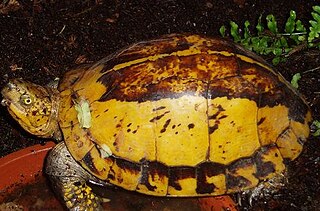
The Indochinese box turtle, Vietnamese box turtle, or flowerback box turtle is a species of Asian box turtles from China, northern and central Vietnam, Laos, and possibly northeastern Cambodia. It is found in high altitude woodland where it tends to hide in the undergrowth. There is considerable confusion as to the taxonomy of this species with several subspecies being recognised by some authorities. and not by others. The International Union for Conservation of Nature has rated its conservation status as "critically endangered".

The Chinese box turtle, also known as the yellow-margined box turtle, or golden-headed turtle, is a species of Asian box turtle. Taxonomically, it is called Cuora flavomarginata.
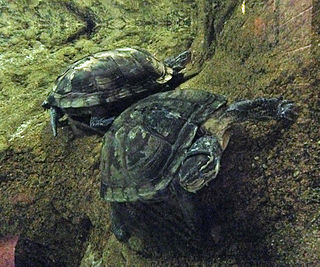
The Vietnamese pond turtle or Annam leaf turtle is a species of turtle in the family Geoemydidae.

Mauremys reevesii, commonly known as the Chinese pond turtle, the Chinese three-keeled pond turtle, or Reeves' turtle, is a species of turtle in the family Geoemydidae, a family which was formerly called Bataguridae. The species is native to East Asia.
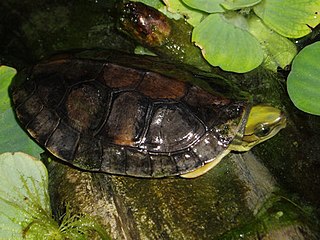
The yellow-headed box turtle or golden-headed box turtle is a proposed species of turtle in the family Geoemydidae. It is sometimes considered a subspecies of Pan's box turtle.
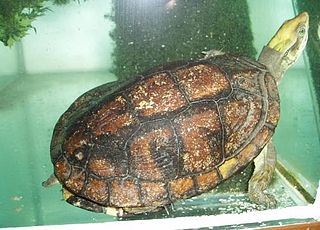
Pan's box turtle is a species of turtle in the family Geoemydidae. The yellow-headed box turtle is sometimes included herein as a subspecies.
The Fujian pond turtle is a possibly also naturally occurring intergeneric hybrid turtle in the family Geoemydidae produced in larger numbers by Chinese turtle farms as a "copy" of the golden coin turtle Cuora trifasciata. It appears to occur in China and Vietnam. Before its actual origin became known, it was listed as data deficient in the IUCN Red List.
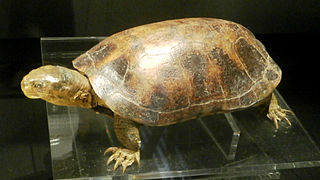
The yellow pond turtle, is a medium-sized, semiaquatic turtle in the family Geoemydidae. This species has a characteristic broad yellow stripe extending behind the eye and down the neck; the carapace ranges in color from grayish brown to brown, and the plastron is yellow or orange with black blotches along the outer edges. It is native to East Asia, ranging from central Vietnam and Laos, north through the coastal provinces of south and central China, with insular populations known from Taiwan, Hainan and the Ryukyu Islands. Although populations in the southern Ryukyus are thought to be native, populations in the northern and central Ryukyus, as well as central Japan, are believed to have been introduced as a result of imports from Taiwan.
Mauremys pritchardi is an interspecific hybrid turtle in the family Geoemydidae. M. pritchardi, described to be from Myanmar, has been found in the wild in China and Japan, and is produced to some extent in Chinese turtle farms. It was listed as data deficient in the IUCN Red List before its actual origin became known.
"Mauremys" glyphistoma is a hybrid turtle in the family Geoemydidae. Originally described as a new species supposedly endemic to Guangxi/China; it was classified as Data Deficient in the IUCN Red List.

The Chinese stripe-necked turtle or golden thread turtle, is a species of turtle in the family Geoemydidae. They are widely distributed in the subtropical regions of Taiwan.
The Chinese false-eyed turtle is a hybrid species of turtle in the family Geoemydidae. It is a hybrid between a male golden coin turtle and a female four-eyed turtle. While formerly considered to be a wild type species believed to be originally from Hainan, it is now known only from pet trade type specimens.
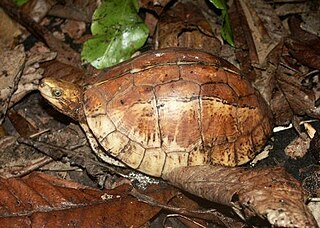
Bourret's box turtle, also known commonly as the central Vietnamese flowerback box turtle and the Indochinese box turtle, is a species of turtle in the family Geoemydidae. The species is endemic to Southeast Asia.
Cuora serrata, originally described as Cuora galbinifrons serrata and later considered a distinct species, are hybrid turtles as shown by genetic studies. These hybrids are bred in the wild and were documented for the first time in the wild in 2005, but not in captivity as "novelty" pets as suggested by James Parham and Bryan Stuart, between the keeled box turtle and taxa of the Indochinese box turtle complex. Unnamed hybrids of several other Cuora taxa are also known, as are intergeneric hybrids like Mauremys iversoni, a hybrid between Cuora trifasciata and Mauremys mutica which are intentionally produced in Chinese turtle farms.

Cyclemys is a genus of freshwater turtles, commonly referred to as Asian leaf turtles, from the family Geoemydidae. The genus occurs throughout Southeast and South Asia, and currently contains seven species.

Box turtle is the common name for several species of turtle. It may refer to those of the genus Cuora or Pyxidea, which are the Asian box turtles, or more commonly to species of the genus Terrapene, the North American box turtles. They are largely characterized by having a shell shaped like a dome, which is hinged at the bottom, allowing the animal to close its shell tightly to escape predators. Furthermore, the two genera are very different in habitat, behavior and appearance, and are not even classified in the same family. Even though box turtles became very popular pets, their needs in captivity are complex and the capture of turtles can have serious detrimental effects on the wild population.

















